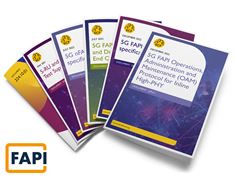SCF releases new FAPI specification to provision L1 SoCs with M-Plane for 7.2x Open Fronthaul
Latest release and updates are part of SCF’s commitment to maintain FAPI as the leading small cells open standard for the industry
LONDON, 20 December 2022; SCF (Small Cell Forum), the global organization supporting the evolution and adoption of low-cost, agile mobile infrastructure, today announced the release of a new specification in the FAPI suite – SCF229 FAPI Operations, Administration and Maintenance (OAM) Protocol For Inline High-PHY, as well as an update to the SCF222 5G FAPI: PHY API specification.

5G FAPI suite
SCF229
FAPI PHY is an agnostic interface for baseband control in a variety of disaggregated and integrated architectures, it is used in millions of the world’s system-on-a-chip based small cells. The newly introduced FAPI OAM (SCF229) interface, brings to Open RAN fuller virtualized support of inline High-PHY implementations in O-RAN Alliance architecture.
The new specification was the result of collaboration between Qualcomm Technologies Inc., and Mavenir, as well as reviewers from Picocom, Radisys and Reliance Jio.
Andrei Radulescu, Staff Engineer at Qualcomm and rapporteur for the FAPI document, said: “O-RAN Fronthaul M-Plane typically terminate in L2/L3, requiring the FAPI suite to convey O-RAN M-Plane content between L2/L3 and L1. This is taken care of in the new specification SCF229.”
SCF222
The version 6 updates of 5G FAPI PHY API brings support for virtual functions and poolable carrier groups; these are key to partitioning L1 SoC resources and integration in virtualized interface in cloudified architectures. The release also includes several MIMO signalling updates:
- a new SU-MIMO Codebook report;
- compact SU/MI-MIMO CSI reports (compact UCI sub-band signalling, to decrease message size);
- compact signalling of semi-static beamforming groups;
- L2-based dynamic spatial stream weights;
- explicit association between spatial streams and port types, for better O-RAN 7.2x Fronthaul integration;
- the specification was further streamlined with multiple maintenance updates.
Radulescu added: “This update brings the L1/L2 interface support to a fully cloudified environment; it also further advances MIMO signalling to support new architectures and macro deployments.
“The new SCF229 specification, together with the updates of the SCF222 are further indication of the FAPI suite evolving and meeting industry requirements, and it demonstrates SCF’s commitment to consistently updating and expanding the API. We have a strong working group team within SCF working on regular FAPI and nFAPI updates, which we will continue to release in 2023.”
The 5G FAPI suite now comprises five documents:
All of the specifications can be downloaded on the SCF website here: https://www.smallcellforum.org/work-items/fapi/, along with more information about the APIs and video presentations discussing them in more detail.
Ends
Contact
For press enquiries contact Claire Marshall, SCF Marketing and Campaign Director.
claire@smallcellforum.org / +44 (0)7771652363
About SCF
SCF (Small Cell Forum) develops the technical and commercial enablers to accelerate small cell adoption and drive wide-scale densification.
Broad roll-out of small cells will make high-grade mobile connectivity accessible and affordable for industries, enterprises and for rural and urban communities. That, in turn, will drive new business opportunities for a widening ecosystem of service providers.
Those service providers are central to our work program. Our operator members establish the requirements that drive the activities and outputs of our technical groups.
We have driven the standardization of key elements of small cell technology including Iuh, FAPI, nFAPI, SON, services APIs, TR-069 evolution and the enhancement of the X2 interface. These specifications enable an open, multi-vendor platform and lower barriers to densification for all stakeholders.
Today our members are driving solutions that include:
- 5G Components, Products, Networks
- Dis-aggregated 5G Small Cells
- Planning, Management and Automation
- 5G regulation & safety
- Neutral Hosts & Multi-operator
- Private and Public Network coexistence
- Edge compute with Small Cell Blueprint
- End-to-end orchestration
The SCF Release Program has now established business cases and market drivers for all the main use cases, clarifying market needs and addressing barriers to deployment for residential, enterprise, rural & remote, and urban small cells. It has also established initiatives relating to both public and private (MNO) coordination.



